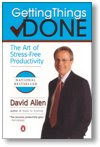Get Everything Done
Posted by The PriorityPro on April 15, 2009 · Leave a Comment

I have been studying the work of David Allen. Many successful entrepreneurs, executives, and employees at every level of the organization have successfully implemented his processes for improving productivity. However, the key to effectively implementing his processes and methodology is to increase your understanding by re-reading his books and applying them to your life in a consistent manner. At the first encounter with David Allen’s work, most people experience greater control, energy, creativity and focus but they let it stop there rather than going deeper. The extreme value is to conscientiously adopt the procuedures continuously in broader contexts. After implementing some of the basic techniques circle back and integrate it more fully and consistently to the rest of your life.
According to David Allen, author of “Getting Things Done: The Art of Stress-Free Productivity”, “Ready for Anything”, and “Making it All Work” there are five discrete stages that he recommends we undergo as we handle our work.
In the first stage, you are collecting things that demand your attention. In this stage it is vital to keep the incoming collection in control by having as few collection means as possible. You collection sources should be emptied on a regular basis! In order to capture everything that might signify something you have to do, you’ll need to gather together everything you feel incomplete with in your life, including, personal or professional, big or little, urgent or minor importance items, and anything that you feel ought to be different than it currently is. It is important to capture everything so that nothing is left in your head. Collection tools could include a physical in-basket, paper-based note-taking devices, electronic note-taking devices, voice-recording devices, and email.
The second stage is processing and the third stage is organizing. These two stages together form the focal point of the decision-tree model. There are a number of key questions to ask yourself about incoming stuff before you can collect it and process it. Firstly, ask what is it? Then define whether or not it is actionable. If no action is required then it is either trash and no longer needed (delete or discard); something that might need to be done later; or, potentially useful reference information. Actionable items need to be linked directly to a project or outcome that you’ve committed to. Then the next activity that needs to be done in order to move the current reality toward completion needs to be defined. This action can be done immediately, delegated, or deferred.
All of the organizational categories need to be physically contained in some form. The total system for organizing just about everything includes non-actionable item categories for trash, incubation tools, and reference storage. When no action is required you can discard it, put it in a tickler file for later reassessment, or file it so you can easily find the material when you need to refer to it in the future. Actionable items are categorized into a list of projects, storage or files for project plans and materials, a calendar, a list of reminders of next actions, and a list of reminders of things you’re waiting for.
The fourth stage involves reviewing the whole picture on a regular basis. A weekly review is a good time to gather and process all your stuff, review your system, update your lists, and get clean, clear, current, and complete. And, the final stage of this system is to decide what you’re going to do at any given point in time.






